
(a)
Interpretation: The product of the given reaction is to be drawn including stereochemistry if appropriate.
Concept introduction: Alkyl tosylates undergo elimination reaction when they are allowed to react with strong nucleophilic base. The mechanism of the elimination reaction is
Answer to Problem 9.69P
The product of the given reaction is,

Figure 2
Explanation of Solution
The given reaction involves treatment of alkyl tosylate with
Alkyl tosylates undergo elimination reaction when they are allowed to react with strong nucleophilic base. The mechanism of the reaction is
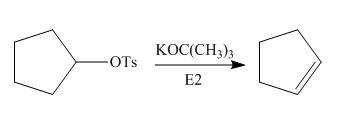
Figure 1
Thus, the product of the given reaction is,

Figure 2
The product of the given reaction is drawn in Figure 2.
(b)
Interpretation: The product of the given reaction is to be drawn including stereochemistry if appropriate.
Concept introduction: The reaction of alcohols with halogen acids
Answer to Problem 9.69P
The product of the given reaction is,

Figure 4
Explanation of Solution
The given reaction involves treatment of an alcohol with
The reaction of alcohols with halogen acids
The corresponding reaction is shown below.

Figure 3
Thus, the product of the given reaction is,

Figure 4
The product of the given reaction is drawn in Figure 4.
(c)
Interpretation: The product of the given reaction is to be drawn including stereochemistry if appropriate.
Concept introduction: Thiols react with
Answer to Problem 9.69P
The product of the given reaction is,
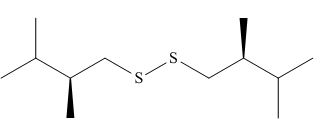
Figure 6
Explanation of Solution
The given reaction involves treatment of thiol with
Thiols react with
The corresponding reaction is shown below.

Figure 5
Thus, the product of the given reaction is,

Figure 6
The product of the given reaction is drawn in Figure 6.
(d)
Interpretation: The product of the given reaction is to be drawn including stereochemistry if appropriate.
Concept introduction: The
Answer to Problem 9.69P
The product of the given reaction is,
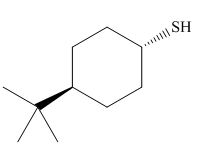
Figure 8
Explanation of Solution
The given reaction involves treatment of alkyl tosylate with
The

Figure 7
Thus, the product of the given reaction is,

Figure 8
The product of the given reaction is drawn in Figure 8.
(e)
Interpretation: The product of the given reaction is to be drawn including stereochemistry if appropriate.
Concept introduction: Alkyl bromides are obtained by the reaction of
Answer to Problem 9.69P
The product of the given reaction is,
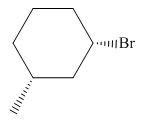
Figure 10
Explanation of Solution
The given reaction involves treatment of secondary alcohol with
Alkyl bromides are obtained by the reaction of

Figure 9
Thus, the product of the given reaction is,

Figure 10
The product of the given reaction is drawn in Figure 10.
(f)
Interpretation: The product of the given reaction is to be drawn including stereochemistry if appropriate.
Concept introduction: Alcohols are converted into alkyl tosylates by treatment with
Answer to Problem 9.69P
The product of the given reaction is,
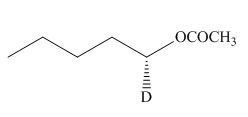
Figure 12
Explanation of Solution
The given reaction involves treatment of an alcohol with
Alcohols are converted into alkyl tosylates by treatment with
 Figure 11
Figure 11
Thus, the product of the given reaction is,

Figure 12
The product of the given reaction is drawn in Figure 12.
(g)
Interpretation: The product of the given reaction is to be drawn including stereochemistry if appropriate.
Concept introduction: The opening of an
Answer to Problem 9.69P
The product of the given reaction is,
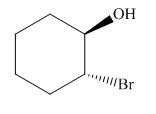
Figure 14
Explanation of Solution
The give reaction involves treatment of an epoxide with halogen acid
The opening of an epoxide/ethylene oxide ring is regioselective either it takes place with a strong nucleophile
The corresponding reaction is shown below.

Figure 13
Thus, the product of the given reaction is,

Figure 14
The product of the given reaction is drawn in Figure 14.
(h)
Interpretation: The product of the given reaction is to be drawn including stereochemistry if appropriate.
Concept introduction: The opening of an epoxide/ethylene oxide ring is regioselective either it takes place with a strong nucleophile
Answer to Problem 9.69P
The product of the given reaction is,

Figure 16
Explanation of Solution
The give reaction involves treatment of an epoxide with
The opening of an epoxide/ethylene oxide ring is regioselective either it takes place with a strong nucleophile
The corresponding reaction is shown below.

Figure 15
Thus, the product of the given reaction is,

Figure 16
The product of the given reaction is drawn in Figure 16.
(i)
Interpretation: The product of the given reaction is to be drawn including stereochemistry if appropriate.
Concept introduction: Ethers are the most common organic products of nucleophilic substitution reaction. They are prepared from alkyl halides and strong nucleophiles. The reaction proceeds through
Answer to Problem 9.69P
The product of the given reaction is,
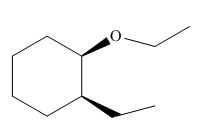
Figure 18
Explanation of Solution
The given reaction involves treatment of a
The alkoxide salts are prepared from alcohols through the Bronsted-Lowry acid-base reaction. In this reaction,
The obtained alkoxide from this reaction contains
The corresponding reaction is shown below.

Figure 17
Thus, the product of the given reaction is,

Figure 18
The product of the given reaction is drawn in Figure 18.
(j)
Interpretation: The product of the given reaction is to be drawn including stereochemistry if appropriate.
Concept introduction: Ethers react with strong acids, (only
In this reaction, both
Answer to Problem 9.69P
The product of the given reaction is,

Figure 20
Explanation of Solution
The given reaction involves treatment of an ether with two equivalents of
Ethers react with strong acids, (only
In this reaction, both
The corresponding reaction is shown below.

Figure 19
Thus, the product of the given reaction is,

Figure 20
The product of the given reaction is drawn in Figure 20.
(k)
Interpretation: The product of the given reaction is to be drawn including stereochemistry if appropriate.
Concept introduction: Sulfides are prepared from thiols by the successive treatment of sodium hydride (a good base), and an alkyl halide. The mechanism of the reaction is
Answer to Problem 9.69P
The product of the given reaction is,
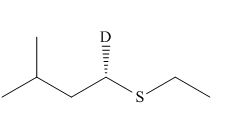
Figure 22
Explanation of Solution
The given reaction involves treatment of an alkyl halide with
The corresponding reaction is shown below.

Figure 21
Thus, the product of the given reaction is,

Figure 22
The product of the given reaction is drawn in Figure 22.
(l)
Interpretation: The product of the given reaction is to be drawn including stereochemistry if appropriate.
Concept introduction: Sulfide involves a nucleophilic sulfur atom. It reacts rapidly with unhindered alkyl halide to form corresponding sulfonium ion. The mechanism of the reaction is
Answer to Problem 9.69P
The product of the given reaction is,

Figure 24
Explanation of Solution
The given reaction involves treatment of sulfide with an unhindered alkyl halide.
Sulfide involves a nucleophilic sulfur atom. It reacts rapidly with unhindered alkyl halide to form corresponding sulfonium ion. The mechanism of the reaction is
The corresponding reaction is shown below.

Figure 23
Thus, the product of the given reaction is,
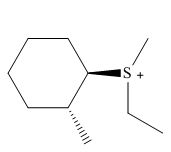
Figure 24
The product of the given reaction is drawn in Figure 24.
Want to see more full solutions like this?
Chapter 9 Solutions
Package: Loose Leaf for Organic Chemistry with Biological Topics with Connect Access Card
- One suggestion for solving the fuel shortage due to decreasing volumes of fossil fuels are hydrogen / oxygen fuel cells. a. State the two half-cell reaction equations for such fuel cells. Calculate the cell potential as well as the electrical work gained by this fuel cell at standard conditions with E002/H20 = 1.229 V. b. Compare the fuel cell to the Gibbs free energy of the combustion reaction of n-octane at standard conditions. Use ASºm, n-Oct., 1 = 361.2 J/mol K.arrow_forwarda. Determine the electrochemical potential of the following cell using E°Mg2+/Mg = -2.362 V. Mg | Mg2+ (a=104) || H* (a = 4) | H2 (p = 0.5 bar) | Pt b. A galvanic chain consists of Co²+ / Co and Ag+ / Ag half-cells with EºCo²+/Co = -0.282 V and Eº Ag+/Ag = 0.799 V. Determine which half-cell will be reduced and which one will be oxidised. Furthermore, calculate the electrochemical potential as well as the equilibrium constant of the whole cell at i. [Co²+] = 0.1 M and [Ag+] = 0.5 M ii. [Co²+] = 0.001 M and [Ag*] = 1.5 Marrow_forwardThe equilibrium voltage of the following cell has been measured at 0.522 V at 25 °C. Pt | H2, g❘ HClaq || AgClaq | Ags State the redox reactions present in this cell. Calculate the pH value of the electrolyte solution with KL, AgCl = 1.96 · 10-10 mol² / L². Assume that the concentrations of H+ and Clare equal.arrow_forward
- Here are the energies (in kcal/mol) for staggered and eclipsed interactions for CH, CC, and CBr bonds eclipsed (0°) staggered (60°) bonds CH/CH 1.0 0.0 CH/CC 1.3 0.0 Br: CC/CC 3.0 0.9 Br CH/CBr 1.8 0.0 CC / CBr 3.3 1.0 CBr / CBr 3.7 1.2 a) I've drawn the Newman projection for one of the staggered conformations of the molecule above, looking down the C2-C3 bond. Draw Newman projections for the other two staggered and the three eclipsed conformations (in order). CH₂ H3C. H' H Br b) Calculate the relative energies for each of the conformations and write them below each conformation.arrow_forward90. Draw the stereoisomers obtained from each of the following reactions: a. H₂ b. H₂ C. H₂ Pd/C Pd/C Pd/Carrow_forward36. The emission spectrum below for a one-electron (hydrogen-like) species in the gas phase shows all the lines, before they merge together, resulting from transitions to the first excited state from higher energy states. Line A has a wavelength of 434 nm. BA Increasing wavelength, λ (a) What are the upper and lower principal quantum numbers corresponding to the lines labeled A and B? (b) Identify the one-electron species that exhibits the spectrum.arrow_forward
- f) The unusual molecule [2.2.2] propellane is pictured. 1) Given the bond length and bond angles in the image, what hybridization scheme best describes the carbons marked by the askerisks? 2) What types of orbitals are used in the bond between the two carbons marked by the askerisks? 3) How does this bond compare to an ordinary carbon-carbon bond (which is usually 1.54 Å long)? H₂C H₂C CH2 1.60Å ハ C. * CH₂ H₂C * C H₂ 120°arrow_forwardQuestion Resonance Forms a) Draw all resonance forms of the molecules. Include curved arrow notation. Label major resonance contributor Resonance Forms a) Draw all resonance forms of the molecules. Include curved arrow notation. Label major resonance contributorarrow_forwardCan you show me or determine the longest carbon chain, which is octane? Potentially highlight it in different sections to show me, plz, or individually?arrow_forward
- PLEASE ANSWER ALL PARTS!!arrow_forwardd) Determine the formal charge on the nitrogen atom in each of the structures. NH3 NH2 N C бобкат : N N H H Н H2N-OH A B C D E F Garrow_forwardLewis Structure, Hybridization & Molecular Geometry a) Draw the Lewis Structure of the molecules; Label the hybridization of each carbon atom; Predict the approximate molecular geometry around each carbon atom. CH3CHO CH3CN b) Draw the Lewis Structure of Nitromethane; Predict the approximate molecular geometry around the nitrogen atom. CH3NO2 c) Draw the Lewis Structure; Label the hybridization of the boron atom; Predict the approximate molecular geometry. BF3 BF4arrow_forward
 ChemistryChemistryISBN:9781305957404Author:Steven S. Zumdahl, Susan A. Zumdahl, Donald J. DeCostePublisher:Cengage Learning
ChemistryChemistryISBN:9781305957404Author:Steven S. Zumdahl, Susan A. Zumdahl, Donald J. DeCostePublisher:Cengage Learning ChemistryChemistryISBN:9781259911156Author:Raymond Chang Dr., Jason Overby ProfessorPublisher:McGraw-Hill Education
ChemistryChemistryISBN:9781259911156Author:Raymond Chang Dr., Jason Overby ProfessorPublisher:McGraw-Hill Education Principles of Instrumental AnalysisChemistryISBN:9781305577213Author:Douglas A. Skoog, F. James Holler, Stanley R. CrouchPublisher:Cengage Learning
Principles of Instrumental AnalysisChemistryISBN:9781305577213Author:Douglas A. Skoog, F. James Holler, Stanley R. CrouchPublisher:Cengage Learning Organic ChemistryChemistryISBN:9780078021558Author:Janice Gorzynski Smith Dr.Publisher:McGraw-Hill Education
Organic ChemistryChemistryISBN:9780078021558Author:Janice Gorzynski Smith Dr.Publisher:McGraw-Hill Education Chemistry: Principles and ReactionsChemistryISBN:9781305079373Author:William L. Masterton, Cecile N. HurleyPublisher:Cengage Learning
Chemistry: Principles and ReactionsChemistryISBN:9781305079373Author:William L. Masterton, Cecile N. HurleyPublisher:Cengage Learning Elementary Principles of Chemical Processes, Bind...ChemistryISBN:9781118431221Author:Richard M. Felder, Ronald W. Rousseau, Lisa G. BullardPublisher:WILEY
Elementary Principles of Chemical Processes, Bind...ChemistryISBN:9781118431221Author:Richard M. Felder, Ronald W. Rousseau, Lisa G. BullardPublisher:WILEY





